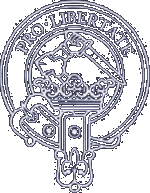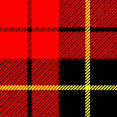
Clan Wallace

Photo of the Wallace Monument
near Stirling, Scotland.
History
There are two theories for the origin of the Wallace name, both of which indicate an ancient British origin. First, the name of Waleis was common in England and around 1300 meant simply "Welsh-man" (originating from the Old French word "waleis" meaning a "welshman"). The family was believed to be from Wales and held land in Shropshire and who may have come north with King David I. The second theory is that they were Britons who settled in the ancient kingdom of Strathclyde, having been driven north in the tenth century. The name is certainly found in records by the twelfth century in Ayrshire and Renfrewshire. The first record of the name was in 1160 when Richard Walensis witnessed a charter by Alan, son of Walter the High Steward.Richard's lands in Ayrshire were named after him and the name survived as the town and parish of Riccarton (Richard's town). His grandson, Adam had two sons, Adam, 4th Laird of Riccarton and Malcolm who received the lands of Eldershire and Auchinbothie in Elderslie, Renfrewshire. Malcolm was the father of Scotland's greatest patriot and hero, Sir William Wallace who led the revolt against English rule before his demise and the advent of the victory achieved at Bannockburn by Robert the Bruce in 1314.
In his early years, Wallace and his mother had to take refuge near Dunipace from the English because they refused to pay homage to Edward I. While still very young, Wallace became the leader of a company of patriots and his harassing tactics against the English earned him the support of many nobles. His military genius made him hated and feared by Edward I, but he was eventually captured by treachery at Robroyson near Glasgow and delivered to Edward I by Sir John Mentieth. Wallace was unjustly tried for treason and brutally executed in London in 1305. Having never sworn fealty to Edward I, he cannot have been guilty of treason against him, however his example kindled a spirit of independence in Scotland which remains to this day. At Stirling on top of the Abbey Craig stands the nation's memorial to Wallace, built in 1896; in 1814 a huge statue was erected to his memory near Dryburgh Abbey in the Scottish Borders. Upon the death of his brother, Lt. Col. Malcolm Robert Wallace, on 9th December 1990, Ian Francis Wallace of that Ilk became the 35th Chief of the Clan, Name and Family of Wallace.
Adam de Waleys appears on the Ragman Roll of nobles paying allegiance to Edward l of England in 1296, but Malcolm of Elderslie was one of very few Scottish nobles who bravely refused to submit to Edward. He and his eldest son, Andrew, were both executed. His wife fled with her younger child, William, to the protection of relatives near Dundee. William gathered a number of young men around him, including a cousin from the Riccarton branch of the family. When he heard that Sir John Fenwick, his father's executioner, was marching towards Dundee with a packed train of plunder from Scottish churches and monasteries, he determined to have his revenge. He met Fenwick at the path leading over Lowden Hill in Lanarkshire, and killed him. His success brought him many new followers, but to gain the support of the nobility he allied himself with Sir Andrew Murray, who was raising a revolt in the northeast. They were joined by the Graharns, the Campbells and the Earl of Lennox. There then began one of. the earliest guerrilla campaigns in military history. The English, unable to capture Wallace, indiscriminately executed a number of the Scots nobility, including his uncle, who had been lured into their hands to discuss possible peace terms. A full-scale revolt commenced in Scotland, but when a strong English army marched to suppress it, resistance melted. Wallace was forced to flee to the north, where he gathered a small force. By 1297, he had gathered enough popular support to lay siege to Dundee. The English sent another great army under the Earl of Surrey and Hugo de Cresslngham. Wallace met the English at Stirling Bridge. (See the Battles of Stirling and Falkirk)
The Wallaces of Craigie, Ayrshire, are descended from Adam Walace of Riccarton, the uncle of the great patriot. They obtained the estate by marriage to the heiress of Sir John Lindsay of Craigie, and in 1669 Hugh Wallace of Craigie was created a Baronet of Nova Scotia. Sir Hugh married Esther Kerr, daughter of the Laird of Little Dean but sadly their only son was brain damaged. On Sir Hugh's death, his grand-nephew, the grandson of his brother, the Rev. William Wallace of Falford, became the second Baronet. He was a distinguished lawyer who rose to the rank of Lord Justice Clerk, the second-highest judge in Scotland. The third Baronet left an only daughter, and was succeeded by his brother, Sir Hew Wallace of Wolmet. Sir Thomas Wallace was the fifth Baronet, and when his son, a captain in the Guards, predeceased him, the estates passed to his daughter, Frances. In 1760 she married John Dunlop of Dunlop, the friend of the poet Robert Burns. His eldest son, Sir John Dunlop, succeeded his maternal grandmother as sixth Baronet of Craigie, and assumed the name of Wallace.
The representation of the chiefly line then passed to another cadet branch, the Wallaces of Cairnhill, who had lived in Jamaica for several generations. Through marriage to an heiress, they inherited estates in Ayrshire at Busbie and Clancaird. In 1888, Captain Henry Wallace of Busbie and Clancaird established himself as chief of the name. Robert Wallace of that Ilk received both the French and the Belgian Croix De Guerre during the First World War. His son, Malcolm, who served in the Second World War, Korea, and Borneo, rose to the rank of colonel. He was succeeded by in 1991 by his brother, Ian, the thirty-fifth chief.
Wallace Tartans
|  |  |
|---|---|---|
| Wallace "dress" | Wallace "hunting" | Wallace "blue" |
Bibliography:
1. Scottish Clans & Tartans; by Ian Grimble
2. Tartans of the Clans and Families of Scotland; by Sir Thomas Innes of Learney
3. Scottish Clan and Family Encyclopedia; by George Way of Plean & Romilly Squire


